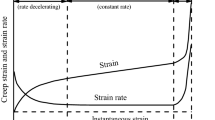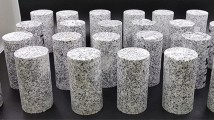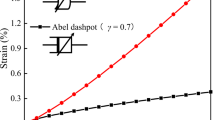Abstract
Time-dependent behaviors of rocks can be attributed to long-term applied stress, which occurs in most underground engineering projects. The creep behavior of granite from the Shuangjiangkou underground powerhouse in western Sichuan Province, China, was investigated via creep tests. It is shown that granite has an obvious creep behavior under different confining pressures and deviatoric stresses. The new dimensionless parameter DPR, which is defined as the ratio of the deviatoric stress to the peak strength, is proposed for experimental analysis. The relationships between the instantaneous strain and final visco-elastic creep strain of granite with DPR are established under different confining pressures. It is shown that when DPR is equal to 0.63, the final visco-elastic creep strain of rocks will reach a minimum value. Based on DPR and the secondary creep strain rate, a unified method for defining the long-term strength of rocks is proposed, and the granite will enter in secondary creep with a nonzero strain rate when DPR > 0.9501. The Nishihara model is improved, and the relationships between the parameters of the improved model with confining pressures and DPR are obtained. The improved creep model can satisfactorily represent the primary creep strain of granite and secondary creep strain of granite with time under a given confining pressure and deviatoric stress.

adapted from Goodman [13])




(adapted from Zhao et al. [15])







Similar content being viewed by others
Code availability
Not applicable.
References
Brantut, N.; Heap, M.J.; Meredith, P.G.; Baud, P.: Time-dependent cracking and brittle creep in crustal rocks: a review. J. Struct. Geol. 52(5), 17–43 (2013)
Sun J.: Rock rheological mechanics and its advance in engineering applications. Chinese Journal of Rock Mechanics and Engineering. 26(6), 1081–1106 (2007) (in Chinese)
Bourgeois, F.; Shao, J.F.; Ozanam, O.: An elastoplastic model for unsaturated rocks and concrete. Mech. Res. Commun. 29(5), 383–390 (2002)
Zhang, Y.; Xu, W.Y.; Shao, J.F.; Zhao, H.B.; Wang, W.: Experimental investigation of creep behavior of clastic rock in Xiangjiaba Hydropower Project. Water Science and Engineering. 8(1), 55–62 (2015)
Bayraktar, A.; Kartal, M.E.; Basaga, H.B.: Reservoir water effects on earthquake performance evaluation of Torul concrete-faced rockfill dam. Water Science and Engineering. 2(1), 43–57 (2009). https://doi.org/10.3882/j.issn.1674-2370.2009.01.005
Yang, W.; Zhang, Q.; Li, S.; Wang, S.: Time-dependent behavior of diabase and a nonlinear creep model. Rock Mech. Rock Eng. 47(4), 1211–1224 (2014)
Boukharov, G.N.; Chanda, M.W.: The three processes of brittle crystalline rock creep. International Journal of Rock Mechanics and Mining Sciences & Geomechanics Abstracts. 32(4), 325–335 (1995)
Dusseault M.B., Fordham C.J.: Time dependent behaviour of rocks. In: Comprehensive Rock Engineering: Principles, Practice and Projects. Pergamon Press, Oxford, UK, 119–149 (1993)
Wang R., Li L., Simon R.: A model for describing and predicting the creep strain of rocks from the primary to the tertiary stage. International Journal of Rock Mechanics and Mining Sciences. 123, 104087 (2019)
Cristescu N.D., Hunsche U.: Time Effects in Rock Mechanics. Wiley, New York, NY, USA, 53 (1998)
Malan, K.; Vogler, U.W.; Drescher, K.: Time-dependent behaviour of hard rock in deep level gold mines. Journal South African Institute of Mining & Metallurgy. 97(3), 135–147 (1997)
Malan, D.F.: Time-dependent behaviour of deep level tabular excavations in hard rock. Rock Mech. Rock Eng. 32(2), 123–155 (1999)
Goodman R.: Introduction to rock mechanics. Wiley, New York, NY, USA, 129–149 (1989)
Amitrano, D.; Helmstetter, A.: Brittle creep, damage, and time to failure in rock. J. Geophys. Res. 111(B11201), 1–17 (2006)
Zhao, Y.; Wang, Y.; Wang, W.; Wan, W.; Tang, J.: Modeling of non-linear rheological behavior of hard rock using triaxial rheological experiment. Int. J. Rock Mech. Min. Sci. 93, 66–75 (2017)
Zhang, H.; Wang, Z.; Zheng, Y.; Duan, P.; Ding, S.: Study on tri-axial creep experiment and constitutive relation of different rock salt. Saf. Sci. 50(4), 801–805 (2012)
Ngwenya, B.T.; Main, I.G.; Elphick, S.C.; Crawford, B.; Smart, B.G.D.: A constitutive law for low-temperature creep of water-saturated sandstones. Journal of Geophysical Research Solid Earth. 106, 21811–21826 (2001)
Campanella, R.G.; Vaid, Y.P.: Triaxial and plane strain creep rupture of an undisturbed clay. Can. Geotech. J. 11(1), 1–10 (1974)
Lajtai, E.Z.; Schmidtke, R.H.: Delayed failure in rock loaded in uniaxial compression. Rock Mech. Rock Eng. 19(1), 11–25 (1986)
Yu, M.; Mao, X.; Hu, X.: Shear creep characteristics and constitutive model of limestone. International Journal of Mining Science and Technology. 26, 423–428 (2016)
Wang R., Li L.: A non-stationary power law model to predict the secondary creep rate of rocks. Proceedings of 8th International Conference on Case Histories in Geotechnical Engineering. (2019)
Bazant, Z.P.; Xi, Y.: Drying creep of concrete: constitutive model and new experiments separating its mechanism. Mater. Struct. 27(1), 3–14 (2019)
Tang, S.; Green, M.S.; Liu, W.K.: Two-scale mechanism-based theory of non-linear viscoelasticity. J. Mech. Phys. Solids 60(2), 199–226 (2012)
Shao, J.F.; Zhu, Q.Z.; Su, K.: Modeling of creep in rock materials in terms of material degradation. Comput Geotech. 30, 549–555 (2003)
Chen, L.; Wang, C.P.; Liu, J.F.; Liu, Y.M.; Liu, J.; Su, R.; Wang, J.: A damage-mechanism-based creep model considering temperature effect in granite. Mech. Res. Commun. 56, 76–82 (2014)
Zhang S., Liu W., Zhang Y., Lin X.: Creep damage analysis of granite based on the principle of minimum energy consumption. Journal of basic science and engineering. 27(1), 210–220 (2019) (in Chinese)
Hu, K.; Feng, Q.; Li, H.; Hu, Q.: Study on creep characteristics and constitutive model for thalam rock mass with fracture in tunnel. Geotech. Geol. Eng. 36, 827–834 (2018)
Maranini, E.; Yamaguchi, T.: A non-associated viscoplastic model for the behavior of granite in triaxial compression. Mech. Mater. 33(5), 283–293 (2001)
Mansouri, H.; Ajallocian, R.: Mechanical behavior of salt rock under uniaxial compression and creep tests. Int. J. Rock Mech. Min. Sci. 110, 19–27 (2018)
Wang, R.; Zhuo, Z.; Zhou, H.W.; Liu, J.F.: A fractal derivative constitutive model for three stages in granite creep. Results in Physics. 7, 2632–2638 (2017)
Singh, A.; Kumar, C.; Kannan, G.; Rao, K.S.; Ayothiraman, R.: Estimation of creep parameters of rock salt from uniaxial compression tests. Int. J. Rock Mech. Min. Sci. 107, 243–248 (2018)
Liu, X.: Introduction to rock rheology. Geological Publishing House. Beijing, China (1994)
Nielsen, L.E.; Landel, R.F.: Mechanical Properties of Polymers and Composites. New York. New York, USA, M Dekker (1993)
Xia, C.C.; Zhong, S.Y.: Experimental data processing method in consideration of influence of loading history on rock specimen deformation. Journal of Central-South Institute of Mining and Metallurgy. 20, 18–24 (1989)
Fahimifar, A.; Karamia, M.; Fahimifar, A.: Modifications to an elasto-visco-plastic constitutive model for prediction of creep deformation of rock samples. Soils Found. 55(6), 1364–1371 (2015)
Sterpi, D.; Gioda, G.: Visco-Plastic Behaviour around dvancing Tunnels in Squeezing Rock. Rock Mech. Rock Eng. 42, 319–339 (2009)
Liu W., Zhang S., Li R.: Accelerated creep model of rock based on energy dissipation theory. Journal of China Coal Society. 44(9). 2741–2750 (2019) (in Chinese)
Zhang, S.; Liu, W.; Lv, H.: Creep energy damage model of rock graded loading. Results in Physics 12, 1119–1125 (2019)
Cong, L.; Hu, X.: Triaxial rheological property of sandstone under low confining pressure. Eng. Geol. 231, 45–55 (2017)
Liu, H.Z.; Xie, H.Q.; He, J.D.; Xiao, M.L.: Nonlinear creep damage constitutive model for soft rocks. Mech Time-Depend Mater. 21, 73–96 (2017)
R.B. Hou, Kai Zhang, J. Tao, X.R. Xue, Y.L. Chen: A nonlinear creep damage coupled model for rock considering the effect of initial damge. Rock Mechanics and Rock Engineering. 52: 1275–1285 (2019)
Lyu H.M., LIU W.B.: Study on creep damage model of granite in Gaode Coal Mine. Coal Science and Technology. 47(3): 125–130 (2019) (in Chinese)
S.J, Niu, W.L. Feng, Jin Yu, C.S. Qiao, S.X. Liu, Y.B. Sun: Experimental study on the mechanical properties of short-term creep in post-peak rupture damaged sanstone. Mech Time-Depend Mater (2019) https://doi.org/https://doi.org/10.1007/s11043-019-09431-2
Xiao F.K., Li R.H., Li L.C., Hou Z.Y.: Deformation and internal damage properties of coal under hierarchical constant load. Journal of Heilongjiang University of Science & Technology. 30(1): 1–7 (2020) (in Chinese)
Wang L., GUO C.B., GUO P.Y., JI F.: Creep character and constitutive model of gneiss in Zilashan area of Sichuan-Tibet railway line. Ceoscience (2020) https://doi.org/https://doi.org/10.19657/j.geoscience.1000-8527.2021.008 (in Chinese)
Li Y.L., Yu H.C., Liu H.D.: Study of creep constitutive model of silty mudstone under triaxial compression. Rock and Soil Mechanics. 33(7): 2035–2040, 2047 (2012) (in Chinese)
Zhang Q., Shen M, Ding W.: Study of mechanical properties and long-term strength of Jinping green schist. Chinese Journal of Rock Mechanics and Engineering. 31(8), 1642–1649 (2012) (in Chinese)
Wu D-S, Meng L-B, Li T-B, Lai L.: Study of triaxial rheological property and long−term strength of limestone after high temperature. Rock and Soil Mechanics. 37(s1), 183–191 (2016) (in Chinese)
Cui X., Fu Z.: Experiment study on rheology properties and long-term strength of rocks. Chinese Journal of Rock Mechanics and Engineering. 25(5), 1021–1024 (2006) (in Chinese)
Li L-Q, Xu W-Y, Wang W., Guo Y-Q: Estimation of long-term strength for Xiangjiaba sandstone based on creep tests. Engineering Mechanics. 27(11), 127–143 (2010) (in Chinese)
Liu, J.; Wang, S.; Yang, H.: Method to determination the rheological test long-term strength for soft intercalations. Site Investigation Science and Technology 5, 3–7 (1996)
Acknowledgments
The authors acknowledge the financial support from the National Natural Science Foundation of China (grant number U1965203) and ‘The research on support time and deformation warning of surrounding rock of large underground cavern group under extremely high stress condition of Shuangjiangkou Hydropower’ (grant number A147 SG). The authors thank Professor Jianfeng Liu for his guidance with the tests.
Funding
The National Natural Science Foundation of China (grant number U1965203) and the research on support time and deformation warning of surrounding rock of large underground cavern group under extremely high stress condition of Shuangjiangkou Hydropower (grant number A147 SG).
Author information
Authors and Affiliations
Contributions
Li Qian performed the experiment and the data analyses, and wrote the manuscript. Jianhai Zhang and Xianliang Wang participated in part of the experiment and helped perform the analysis with constructive discussions. Yonghong Li and Zhiguo Li prepared for samples of the experiment and checked the results of the test. Ru Zhang and Nuwen Xu conceived and designed the analysis.
Corresponding author
Ethics declarations
Conflict of interest
The authors declare there is no conflicts of interest regarding the publication of this paper.
Availability of data and material
All data generated or analyzed during this study are included in this published article.
Rights and permissions
About this article
Cite this article
Qian, L., Zhang, J., Wang, X. et al. An Improved Creep Model for Granite Based on the Deviatoric Stress-to-Peak Strength Ratio. Arab J Sci Eng 46, 5157–5170 (2021). https://doi.org/10.1007/s13369-021-05441-w
Received:
Accepted:
Published:
Issue Date:
DOI: https://doi.org/10.1007/s13369-021-05441-w




